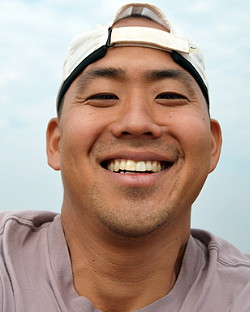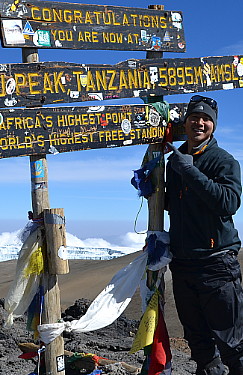Kenji's Story

Kenji was 27 when he was diagnosed with Ewing's sarcoma of the brain. His treatments included surgery, proton radiation therapy, and chemotherapy.
After experiencing a paradigm shift as a volunteer working at one of the biggest slums in Kenya, I decided to commit my career to improving the health of people in need. In 2005, I was conducting research in Tanzania and I was trying to reach out to the underserved community as much as I could. I was able to send 12 orphans to school after raising funds in a volleyball tournament, and I later spent Christmas day at the same orphanage. Working with a charity, I helped establish a small-scale, pen-pal cultural exchange program between middle and high schools in Tanzania and the United States. It was an exciting time; I was living in my dream.
Diagnosis
My life took a huge turn in 2007. I experienced headaches that lasted for several weeks, and I assumed I had a minor illness like those that are common in developing countries. I self-treated with Tylenol. After my friends’ persistent requests, I hesitantly agreed to seek medical attention. Little did I know that I was going to be scheduled for an MRI within two hours, even though it was after business hours at the only hospital in the entire country equipped with an MRI machine. The images revealed a tumor the size of a golf ball in the right frontal lobe of my brain. A senior Tanzanian doctor ordered me to be medically evacuated in the United States. I was extremely puzzled: I was 27 and in the best shape, physically and mentally. With a week's worth of clothes packed, I flew back to Boston, Massachusetts.
Treatment
Within days of my arrival, I was scheduled for surgery at a hospital in Boston. After seven hours of surgery, the surgeon successfully removed all visible parts of the tumor from my brain. Soon I received my diagnosis: PNET (primitive neuroectodermal tumor) with two to three months of life remaining. I was puzzled. I felt as if I was watching a well-acted TV drama. The doctors prescribed proton radiation followed by a course of chemotherapy. I underwent six weeks of proton radiation at MGH, which was then one of only four locations in the United States that provided the treatment. The radiation was difficult to endure, but it came with minimal side effects. Despite the doctors’ recommendation, I exercised. To me, that was the only way to find myself. A subsequent lumbar puncture indicated that the treatment was successful.
While undergoing radiation, I decided to seek a second opinion on my diagnosis. PNET, a rare pediatric cancer, just seemed questionable. The second pathology results from a different hospital in Boston indicated that my initial diagnosis was incorrect, and a third opinion from a hospital in New York confirmed this decision. My new diagnosis was a rare presentation of Ewing’s sarcoma. Some oncologists claimed that no literature to date documented a case like mine. Because of its rarity, doctors at the first hospital had neglected to test the tumor fully, assuming that it could not be Ewing’s sarcoma. Hearing the news, I felt relieved because Ewing’s sarcoma is much more receptive to chemotherapy, but I felt alone.
The new diagnosis of Ewing’s sarcoma resulted in a new treatment plan. I underwent an 11-month regimen of five different drugs, given in 2-3 week intervals, alternating in-patient for five days and outpatient for two days. On October 1, 2008, I finally completed my cancer treatment. It was an arduous experience, but I learned a great deal through it, mainly that the support of my friends and family around the world is a medicine no doctor can provide.  I have been given a second life, and this time with a clear vision: I will continue to use my skills and talent to help improve the health of people in need.
I have been given a second life, and this time with a clear vision: I will continue to use my skills and talent to help improve the health of people in need.
Life Now
Three months after the completion of the treatment, I joined Doctor Without Borders as an epidemiologist to help fight the dual epidemic of HIV/AIDS and TB in Swaziland. A year and a half later I summited Mount Kilimanjaro, the highest mountain in the African continent. Some argued that my actions were too risky then, but I needed to prove to myself that I am healthy and that I can still achieve my dreams. Later, in Uganda, I worked on improving the national cancer care and treatment program.
My life after cancer continues to be a challenge, but I am stronger mentally every day and am moving forward one step at a time. Today, I am grateful for all the lessons I learned from cancer survival.
